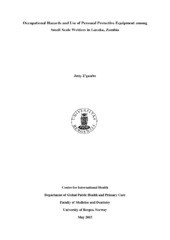| dc.description.abstract | Introduction Welding is associated with various inherent occupational hazards which may result in severe consequences on health of workers performing this task. Very little information exists regarding health hazards and how they are controlled among welders in developing countries. For instance, there is limited information on use of personal protective equipment or work related health problems within this occupational group. Little information is published concerning welders in Zambia, although the number of welders is increasing, especially in small scale enterprises. Thus, the study aimed to gather information about occupational hazards and use of personal protective equipment (PPE) among small scale welders in Lusaka, Zambia. Acute health effects experienced by the welders were also explored as well as the welders' awareness regarding occupational hazards and use of PPE. Methods This was a cross sectional study of 430 small scale welders conducted in Lusaka, Zambia. A pretested structured interview guide and checklist was used to collect data on demographic characteristics, work experience and occupational hazards, awareness of PPE and hazards, use of PPE and acute health effects experienced. Descriptive statistics were used in the analyses of data, Chi square and ANOVA tests were used for comparing study variables and a generalised linear model with a log link function was used to derive relative risks. Results It was found that welders were exposed to welding hazards such as intense bright light, heat, noise, fumes and gases. Other hazards arose from poor housekeeping, unsafe work structures and tools such as grinders. Although the majority (98%) of welders were aware of at least one type of welding hazard or PPE, about 2% were not aware of any hazards or any personal protective measures. None of the welders used all the recommended PPE at any time during their work. A high prevalence of self-reported eye (88%) nasal (78%), metal fume fever (68%) and respiratory (64%) related symptoms was found in addition to burns (87%) and cuts (79%) on hands/arms. Education was associated with awareness regarding hazards and PPE as well as use of PPE. Conclusion Welders in this study worked under poor and dangerous conditions that exposed them to several safety and health hazards. Although most welders were aware of occupational hazards and related PPE for their work, this awareness did not translate into use of PPE. Their use of protective measures did not offer the level of protection required considering that a high prevalence of acute health effects was found among the welders in the study. This calls for concern and need for more preventive measures within this occupational group to avoid injuries and diseases. | en_US |
